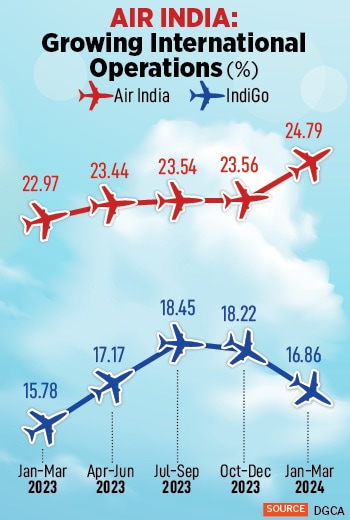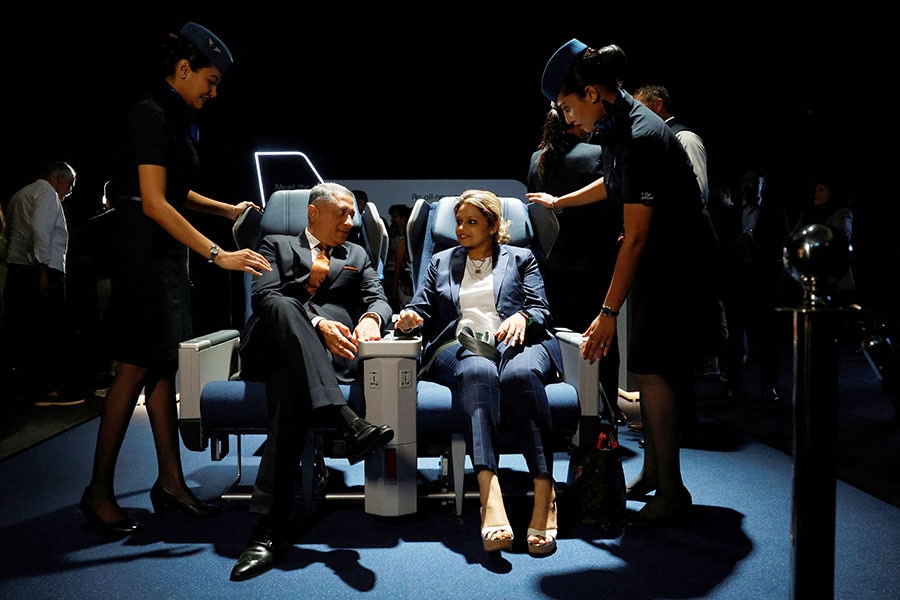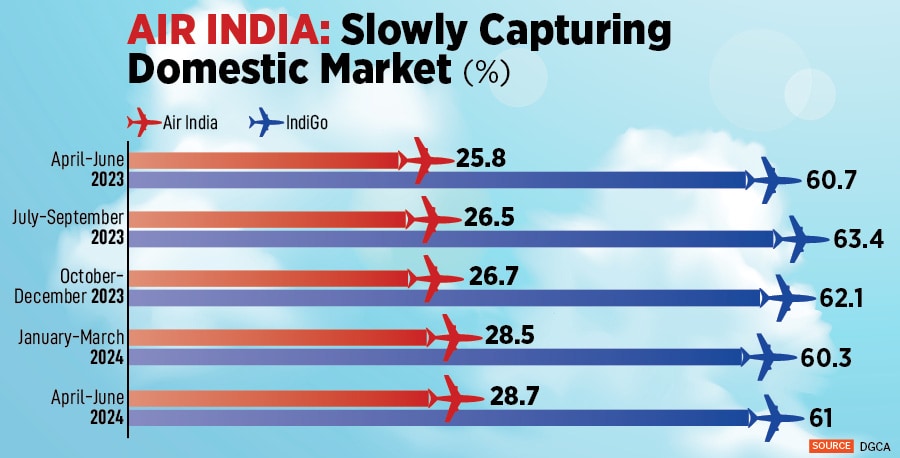But, at the end of it, if there’s a silver lining, it’s that nobody knows Indian skies better than IndiGo, having proven that in the past 18 years. From its launch in 2006 into a market that was dominated by the likes of Jet Airways and Air Deccan to now cornering over 60 percent of the Indian market, IndiGo has pushed through a low-cost proposition that’s become something of a norm and even a case study on surviving the brutal Indian skies, all while raking in impressive profits.
That’s why all eyes are now on how the Gurugram-headquartered airline is attempting to reinvent luxury travel, a realm it hasn’t dabbled in so far, as it unveiled its version of the business class. For nearly two decades, the airline had shunned that idea and offered only economy seats, with paid-for meals and charging for services such as seat selection, without access to lounges.
Now, besides the business class, the airline is also launching a frequent flyer programme, a loyalty programme that helps to redeem points for flights or other rewards, making it the only low-cost carrier in India to offer it apart from Air India Express. Considering it flies six out of every 10 passengers in the country, and ferries as many as 10 crore passengers annually, the frequent flier proposition has already raised eyebrows.
“With India’s soaring economy and the evolving aspirations of the Indian society, it’s time for us to redefine air travel once again and provide our evolving customers more benefits as they travel the world on us," Pieter Elbers, CEO of IndiGo, said in a statement.
As part of its transition from a low-cost airline into something of a hybrid carrier, IndiGo will launch business class tickets on a total of 12 routes, starting with Delhi-Mumbai at Rs18,000 one way. The company will then expand its services to other metros, including Bengaluru, Chennai, Kolkata and Hyderabad.
That means, from its fleet of over 220 narrow-body aircraft, primarily the Airbus A321, about 40 aircraft will be fitted with the dual-class cabin. Already, the airline has begun offering in-flight entertainment on a mobile app, a serious departure from its no-frills business model. “IndiGo’s plans mark a clear shift in strategy from a pure-play low-cost carrier (LCC) towards a full-service or a value-based offering," says Satyendra Pandey, managing partner of aviation advisory AT-TV. “The transition does add complexity and cost to the airline, but IndiGo’s internal assessment is that the benefits are significant."
AT-TV estimates that the frequent flyer programme coupled with the business class offering will provide for between a 3 percent and 8 percent bump in revenues between the next 12 and 18 months. “This is based on the IndiGo network and market share coupled with competitor weakness," adds Pandey. “As costs will only see a marginal increase, overall, this is an accretive step."
Still, it doesn’t take away from the fact that IndiGo’s move is something of a counterstrike against Air India, IndiGo’s closest rival in India’s duopolistic airline market, that has been in the midst of a $75 billion makeover. Air India is ramping up on its international and domestic offerings with a slew of changes that include revamped cabins and in-flight experience, new aircraft and crew, alongside adding new routes. “IndiGo’s moves look like a pre-emptive strike as the Air India group is gaining momentum," says Shukor Yusuf, founder and CEO of Singapore-based Endau Analytics, an aviation consultancy firm. “It"s a way to try to divert business from the competitor."
![]() And there might just be a growing case for it. From a market share of 26.7 percent in the domestic market between October and December 2023, Air India group’s market share has grown to 29.1 percent in the quarter between April and June this year. On the international routes, from a market share of 23.56 percent during the October-December quarter in 2023, the Air India group has grown its share to 24.79 percent during the January-March quarter IndiGo has seen that number decline from 18.22 percent to 16.86 percent. The Directorate General of Civil Aviation (DGCA) is yet to release data for the April to June quarter.
And there might just be a growing case for it. From a market share of 26.7 percent in the domestic market between October and December 2023, Air India group’s market share has grown to 29.1 percent in the quarter between April and June this year. On the international routes, from a market share of 23.56 percent during the October-December quarter in 2023, the Air India group has grown its share to 24.79 percent during the January-March quarter IndiGo has seen that number decline from 18.22 percent to 16.86 percent. The Directorate General of Civil Aviation (DGCA) is yet to release data for the April to June quarter.
“Air India"s recent expansion likely played a role in prompting IndiGo"s decision to launch a business class service, as IndiGo seeks to defend its market share," says Alok Anand, chairman and CEO of Acumen Aviation, an aircraft asset management and leasing company. “Although IndiGo is widely regarded as the dominant airline in India, Air India is now positioning itself to challenge this status. The profitability of international ticket sales tends to be higher than domestic ones, and international travellers are generally more inclined to pay for premium services. This market shift may have influenced IndiGo"s strategy to offer a more upscale product."
What’s coming?
Starting November, IndiGo will offer IndiGoStretch, its version of business class that features a coupe-style, two-seat wide bay, with specially curated meals from the luxury hotel chain, Oberoi. The seats will have a pitch of 38 inches and a width of 21.3 inches in addition to an adjustable headrest, electronic device holder and power outlets. Its business class proposition also includes benefits such as nil convenience fee, beverages and advance seat selection at no additional charge along with priority check-in. The fares start at Rs18,018.
By the end of the year, IndiGo will have as many as 40 Airbus A321s fitted with the new configuration, which will have four rows of seats with two on each side against the current configuration of three. “The rationale behind going for a business class and a frequent flyer programme is two-pronged," says Vinamra Longani, head of business for Asia & Middle East at Amsterdam-headquartered aviation consultancy firm SGI Aviation. “One, the move shores up more revenue from its full-service codeshare partners, and IndiGo has quite a lot of them. The second is that, as it starts its A350 service, it helps to feed business travellers into that from all over the country."
IndiGo’s codeshare partners include the likes of Turkish Airlines, Qantas, Qatar Airways, American Airlines, British Airways, Air France-KLM, Japan Airlines and Virgin Atlantic. A codeshare agreement is a pact to issue and accept tickets for flights that are operated by the partner airline. Through the partners, IndiGo currently operates to as many as 80 destinations across the world.
The airline has also ordered as many as 30 Airbus A350-900, a wide-bodied aircraft that will help the airline go big on its long-haul operations. The airline currently has an outstanding order book of almost 1,000 aircraft comprising a mix of A320NEO, A321NEO, A321XLR aircraft, and Airbus A350. The Airbus A350 is expected to join the fleet in 2027.
The recent proposals—while they might add to the top line—are also expected to incur significant costs. For years, IndiGo has perfected the art of keeping a tight leash on its financials, having traditionally operated only one kind of aircraft, and through its famed sale and lease back programme. It’s only a few years ago that it began adding the much smaller ATR aircraft to its fleet to undertake regional operations. “This move will demand significant investment in cabin layout, seats, crew training and catering to name a few," says Anand of Acumen Aviation. “If the execution is right, as has been the case with IndiGo in the past too, it can surely result in better revenues and profitability."
Besides, there will also be a culture clash at the airline, that it now needs to figure out. “Unlike other airlines, IndiGo has treated all its passengers equally since there was only economy class in their aircraft," adds Longani. “It was the same seat for everyone. As it turns into a hybrid airline from a low cost, and competes with Air India/Vistara for business class passengers, it must alter the organisation’s DNA, ensuring expectations of these customers are met. Operationally and from a product perspective, too, that means enhancing their offering to match that of its rivals unless the IndiGo business class product is priced lower than that of its direct competitors."
![]() Members of the crew of Indian airline IndiGo demonstrate facilities in business-class seats, that will be introduced from mid-November on a handful of domestic routes, at a company event in New Delhi, India, August 5, 2024.Image: Reuters /Priyanshu Singh
Members of the crew of Indian airline IndiGo demonstrate facilities in business-class seats, that will be introduced from mid-November on a handful of domestic routes, at a company event in New Delhi, India, August 5, 2024.Image: Reuters /Priyanshu Singh
Then, there is also the conundrum most airlines have struggled to deal with, especially when it comes to the business class proposition. Such travellers usually fly in the mornings or evenings, which means aircraft often struggle with empty business class seats during the rest of the day. “Having premium cabins is one thing, but getting revenue out of them is a different ball game altogether," says an industry expert on conditions of anonymity. “There was no need for IndiGo to go for this… it could have continued growing on its merit. Perhaps, Rakesh Gangwal’s decision to step back has steered the airline into new frontiers."
IndiGo was founded by Rakesh Bhatia of InterGlobe Enterprises and Rakesh Gangwal, an aviation veteran, in 2006. Over the last few years, the duo has had a public fallout with Gangwal stepping away from the board, and Bhatia assuming greater control of the airline. Gangwal has since sold some of his stake in the airline.
“I agree that IndiGo"s new offering is more akin to an enhanced premium economy rather than a full-fledged business class, given the seat configuration and the absence of hot meals," adds Anand. “While this category might appeal to domestic travellers seeking a higher level of comfort, international passengers might still prefer the full business class experiences offered by airlines like Air India, Emirates, and others, which include luxuries like flat beds and gourmet meals. This preference might shift if IndiGo further upgrades its product for international markets."
Already, the airline has revamped its website and app as a prelude to its plan to make seamless booking, something that Air India completed last year. Air India had also launched an upgraded version of its loyalty programme that would see customers earn points based on their spending while also ensuring that the points did not expire if the passenger flies with Air India once every two years. IndiGo, too, is launching a new loyalty programme that ensures the accumulation of points on every flight based on their spend in addition to free redemption and tier upgrades.
“Indians are price-sensitive and those who can afford business or premium class won"t settle for halves," adds Yusof. “IndiGo will always be seen as a low-cost carrier, like AirAsia in Malaysia. I don"t see the need to alter its business model."
![]()
What’s Air India doing?
Air India is currently in the middle of a merger involving Vistara, which will see the airline evolve into India’s online full-service airline, with a fleet of nearly 200 aircraft. Air India Express, the low-cost arm of the airline, has a fleet of over 80 aircraft. The Tata group-owned Air India is now expecting delivery of 470 aircraft that it had ordered from both Airbus and Boeing.
But it’s the merger between Air India and Vistara that could emerge as a game changer, with the merged entity now capable of offering a proposition that could shake up the domestic market, especially with its large fleet size and full-service option. Besides Vistara and Air India, no other airline in India, the world’s fastest-growing aviation market, offers a full-service option. Since its acquisition in 2021 by the Tatas, Air India has put in place a five-year transformation plan, called Vihaan.ai, that has already seen the airline focus heavily on timely performance, staff behaviour, and a young fleet.
“The Air India of today is not the Air India of yesterday and the Air India of today is certainly not the Air India of tomorrow," Campbell Wilson, CEO of Air India, had told Forbes India last year. Already, Air India Express and AirAsia India had merged last year to create a single entity, Air India Express, that now flies to 47 destinations and has as many as 10 hubs.
In the process, the idea is to use the low-cost arm to feed into the international options and connect smaller cities to the international route. Air India has been frequently adding to its foreign network, especially in North America and Europe, and its recent order of more than 70 wide-bodied aircraft, including Airbus A350 and Boeing 787 and 777, are aimed at enhancing its international operations.
“In addition to Air India upping the ante on the full-service front, its low-cost arm, Air India Express, is growing exponentially too, and will have a fleet of close to 100 aircraft by the end of this year," adds Longani. “While Express plays in the same space as IndiGo, it provides hot meals and has ovens on board. Despite its size and market dominance, IndiGo may be impacted. So, in many ways, the current move is IndiGo’s way of saying to the Air India group, if you come after mine, I will come after yours."
Still, despite the million little steps, a noteworthy turnaround at Air India is still a work in progress, especially since the airline has seen its fair share of troubles that include pilots at Vistara going on strike ahead of its merger and continuing complaints about flying experience that range from non-functioning in-flight entertainment systems to broken seats. Last year, the airline was in the eye of a storm for mishandling an issue when a passenger reportedly urinated on another passenger in-flight, while this year, it drew flak after inordinate delays in rescuing passengers stranded in Russia following an emergency landing.
IndiGo, too, has seen some dip in its service quality, with on-time performances, something that the airline had earlier flaunted, taking a hit in recent times. In June, IndiGo’s on-time performance at the four metros was only the fourth best after Akasa, Vistara and Air India Express. “That’s a result of the growing codeshare agreements," says an industry expert. “You have to wait for incoming international passengers, and all that that affects operational efficiency."
Still, IndiGo seems best poised in India’s fast-growing aviation market for now. “IndiGo is likely to maintain its leading position in the Indian aviation market for at least another decade, as competitors like Air India and others will need time to catch up," says Anand of Acumen. “The aviation industry is currently facing unique challenges, such as supply chain issues and technology-driven manufacturing delays, which hinder the acquisition of new aircraft. This situation benefits established players like IndiGo. By introducing new offerings like its recent business class service, IndiGo demonstrates a commitment to innovation and responsiveness to market demands."
“Structurally, IndiGo is in a very competitive position and over the next few years, if it is able to maintain its cost advantage while adding products that drive revenue, it should bode well for the airline," adds Pandey of AT-TV.
All that means, for now, all eyes are on November, when IndiGo’s new product offering goes live. It had once disrupted India’s aviation sector for good. Can it repeat the same in changed circumstances? Only time, and perhaps its value proposition can tell.

 And there might just be a growing case for it. From a market share of 26.7 percent in the domestic market between October and December 2023, Air India group’s market share has grown to 29.1 percent in the quarter between April and June this year. On the international routes, from a market share of 23.56 percent during the October-December quarter in 2023, the Air India group has grown its share to 24.79 percent during the January-March quarter IndiGo has seen that number decline from 18.22 percent to 16.86 percent. The Directorate General of Civil Aviation (DGCA) is yet to release data for the April to June quarter.
And there might just be a growing case for it. From a market share of 26.7 percent in the domestic market between October and December 2023, Air India group’s market share has grown to 29.1 percent in the quarter between April and June this year. On the international routes, from a market share of 23.56 percent during the October-December quarter in 2023, the Air India group has grown its share to 24.79 percent during the January-March quarter IndiGo has seen that number decline from 18.22 percent to 16.86 percent. The Directorate General of Civil Aviation (DGCA) is yet to release data for the April to June quarter.
